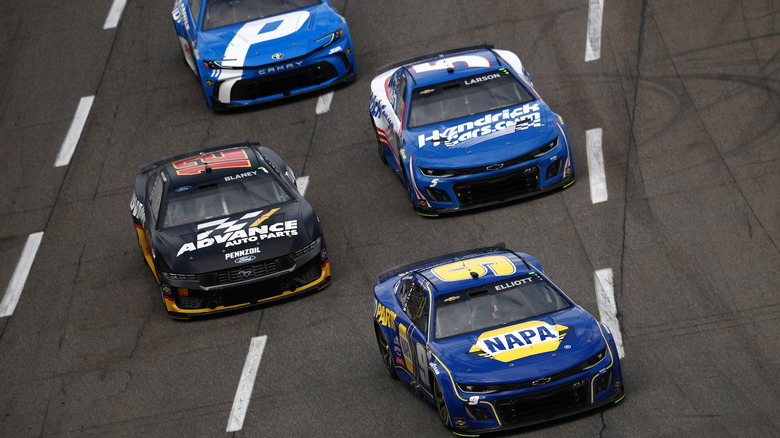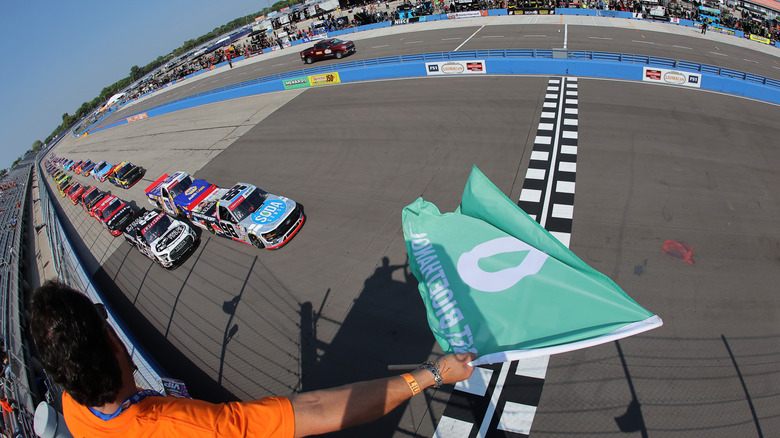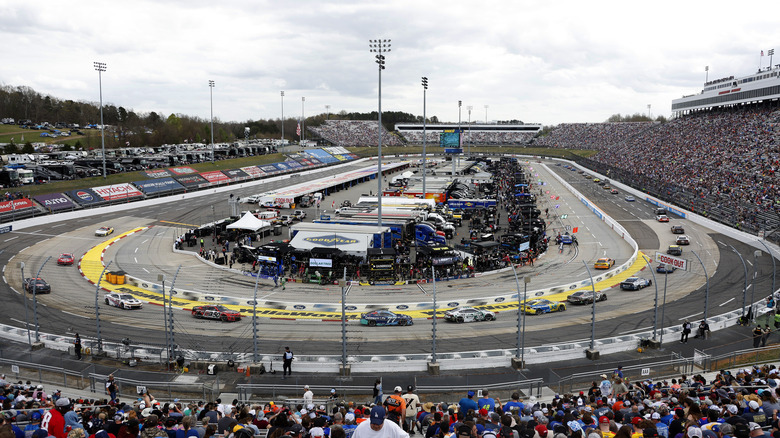This Is The Oldest NASCAR Track Still In Use Today
When Chase Elliot crossed the finish line at Winston-Salem, North Carolina's Bowman Gray Stadium on Feb. 2, it kicked off what will surely be a thrilling 2025 NASCAR Cup Series. With 38 races across 29 tracks throughout the United States and Mexico, fans of America's fastest sport know these tracks' characters as much as they do the racers and cars.
Much like the PGA's collection of historic golf courses, each racetrack comes with a unique layout and features, making every race a distinct challenge. From superspeedways like Daytona and Talladega to the short track at Bristol, Tennessee and the road course of NASCAR's Circuit of The Americas, the NASCAR Cup Series plays out across a host of unique raceways. NASCAR's iconic venues bring a pageantry that elevates the stakes of the sport's most important races far beyond their point totals. Home to top-speed NASCAR cars and some of the most memorable moments in NASCAR racing history, these venues have cemented themselves into American sports lore through decades of high speeds, photo finishes, and historic victories.
Which of these historic tracks holds the title for NASCAR's oldest is a bit of a debate amongst diehards. One course claims the belt due to being the oldest auto racing course, another deems itself NASCAR's most historic current venue, and a third claims to have the record for the longest continual tenure of NASCAR races. Which course takes the prize? Dive into their histories to find out.
America's oldest racetracks
As the world's longest-tenured auto racetrack, the Milwaukee Mile makes a strong claim as NASCAR's oldest course. Built as a horse track in 1876 — the year Alexander Graham Bell patented the telephone — the track at Wisconsin State Fair Park has hosted auto racing since 1903. A 1.015-mile short track, the Milwaukee Mile has seen a long list of racing legends, including Barney Oldfield, A.J. Foyt, and Mario Andretti. It even served as the home of the Green Bay Packers, who played in its infield from 1934 to 1953.
Unfortunately for its title as NASCAR's oldest track, America's fastest racing has only used it intermittently, and didn't begin speeding around its oval until 1984, during the Busch Late Model Sportsman series. Further damaging its claim: the Milwaukee Mile isn't on NASCAR's 2025 calendar due to a scheduling conflict, putting NASCAR's future relationship with its oldest racetrack in jeopardy.
With Milwaukee's departure from the circuit, another one of the world's most iconic racing venues lays claim to the oldest track on NASCAR's schedule: the Indianapolis Motor Speedway. Built in 1909, the 2.5-mile track is one of the world's most historic sporting venues, hosting every Indianapolis 500 since 1911. Despite its prestige, though, the speedway's relationship with NASCAR is relatively recent; it first hosted the Brickyard 400 in 1994, when Indiana racing legend Jeff Gordon took home the gold. So while this is NASCAR's most storied track, a different venue's history with NASCAR stands above the rest.
Martinsville Speedway – granddaddy of the 2025 circuit
Despite the historic run of America's oldest racetracks, the Martinsville Speedway hosts the longest-running NASCAR race and is the most tenured track on the 2025 circuit. Located in Ridgeway, Virginia, the half-mile loop is the only course to host a NASCAR Cup Series race every year since its inaugural season in 1949.
Robert "Red" Byron, the Cup Series' inaugural champion, won the first of the speedway's stock series races on Sept. 25, 1949. Beating 14 other drivers in his 1949 Oldsmobile, Byron led for nearly half of the 200-lap event, kicking off a fascinating era of stock-car racing. These early races look much different than the sport fans know today, sporting race cars you probably had no idea competed in NASCAR, ranging from VW Beetles to the Aston Martin DB2. Many of the races even sped down dirt tracks, including Martinsville.
In the 76 years since, Martinsville has retained much of its original character, retaining its track configuration despite upgrading to asphalt in 1955. One of the shorter tracks on the circuit, the course is popular among fans for hosting the Xfinity 500 — a staple of the sport's late playoff push. In an interview with Forbes, Clay Campbell, Martinsville Speedway's president and grandson of founder Clay Earles, credited the track's success to its historic roots. "When a fan comes to Martinsville," he said, "... they can feel the presence of all the greats that have been at this speedway."


